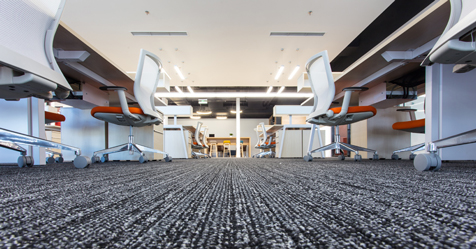Carpet cleaning technicians and contractors that clean carpets often struggle with drying times. The client obviously wants the carpet to dry as fast as possible so the area can be put back into service. However, this can present a safety issue.
Walking from a damp carpet onto a hard surface floor can be dangerous. As a result, proactive residential carpet cleaners know to now provide advance warning to customers, alerting them to a potential slip-and-fall hazard while the carpet is wet.
Wet carpet impacts more than the safety of building occupants; it also impacts the effectiveness of the cleaning job. As long as the carpet is wet, it is more susceptible to rapid resoiling. Dust and dry soil that might have little or no impact on a carpet when dry can quickly turn to mud and damage the carpet’s appearance. Additionally, damp carpets may still contain some cleaning solution residue. If present, the residue acts like a magnet, collecting soils, dust, and grime.
So, how can we get carpets to dry faster after cleaning? It starts with the extractor. Technicians should make sure their machine’s vacuum motor, filter, and hoses are working properly. Additionally, the extractor’s wand can play a major role in carpet drying times.
However, once we are sure equipment is working properly and know we are using the best wand for the job, the most effective way to dry carpets is through the use of air movers. These are not fans as you might find in a hardware store. Typical fans are designed to facilitate air movement over a wide area and not necessarily the carpet. Instead, air movers are professional systems designed to blow large amounts of air directly over the carpet, allowing more moisture to become airborne and evaporate.
There are different types of air movers available, but the following are the most commonly used to reduce carpet drying times:
Centrifugal: These are a very common type of air mover. The fan sits on top and blows air directly over the carpet surface. Technicians should select a centrifugal air mover that allows for two- or three- speed settings. When drying floor finish, a lower setting would likely be best; for carpet, a higher setting is suggested. Some centrifugal air movers can be adjusted for multiple angles, which allows them to be used for different drying needs.
Downdraft: This equipment pulls drier, often warmer air from above and drives it down—thus the name, downdraft—across the carpet or floor surface. The air is released in a 360-degree pattern so it can help dry a large area. In some cases, carpet in an entire room may be dry in about 20 minutes.
Low-profile: Sometimes referred to as “snail” or “whistle” air movers,these systems operate in similar ways to centrifugal air movers.As air is drawn into the unit, it releases through the snout of the machine, allowing for direct, high-volume air movement. These types of air movers have two special features: First, they are typically very light so they can be easily moved from place to place. Second, some are stackable—one unit can be placed directly on top of another unit— so they can be stored and transported more conveniently.
Air movers should be used as the carpet is cleaned. For instance, as soon as a hallway is clean and before starting on the next area, place an air mover at either end of the hallway that was just cleaned. For very long hallways, a general rule of thumb is to place at least one unit for every 200 feet. This means that a 400-square-foot room, for example, will likely need two air movers. Positioning them in corners can help improve air circulation. These best practice rules apply not only to hallways, but to all types of areas.
As to which systems to use, start with the centrifugal and downdraft systems. The low-profile units are typically used for more specific and smaller areas. In many cases, a carpet can be dry by just letting an air mover perform its magic for about 20 minutes. If not completely dry, it will certainly help reduce drying time significantly.
Many of these systems can be used in similar ways to dry damp, freshly-finished, or flood-damaged floors. The same process that helps carpets dry faster helps hard surface floors dry faster, as well.
It’s important to note there can be situations where moisture seeps down to the carpet pad, and even the floor below. An effective carpet extractor—when properly used—should prevent this from happening. However, if it does occur, one way to deal with this is to pull up the carpet in the problem area and place a centrifugal or low-profile air mover so that it blows directly over the pad and/or floor. Depending on the amount of moisture, allowing the system to operate for up to 30 minutes should help.
Using air movers should be viewed as the second half of carpet extraction. Not only does this benefit the customer and promote safety, but it can help protect carpet fibers and the backing of the carpet, and help improve the overall look of the carpet, as well.



